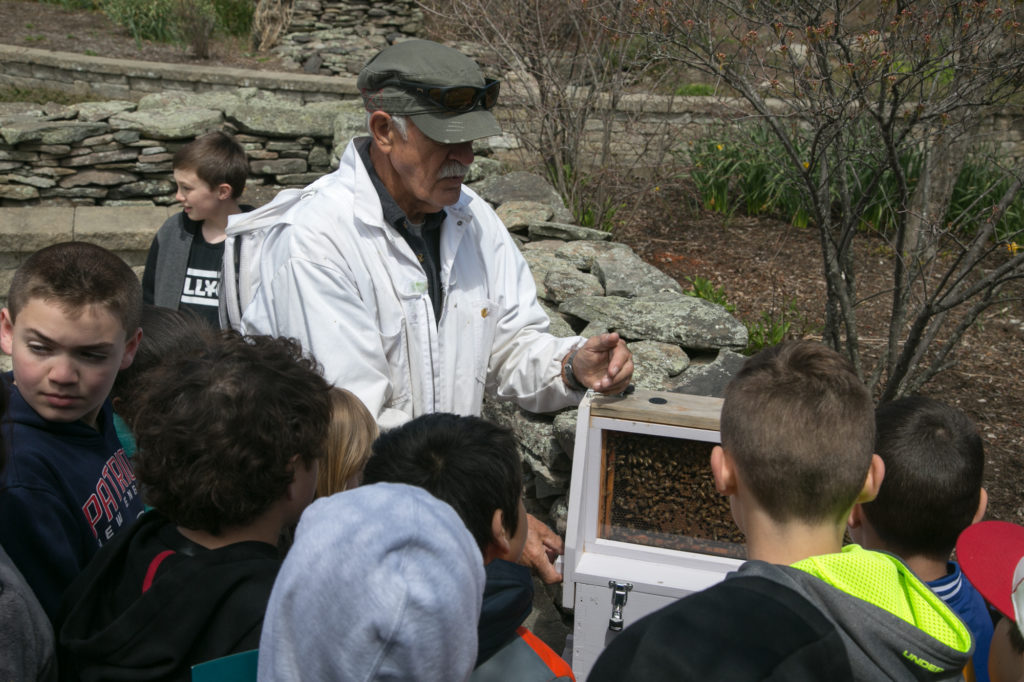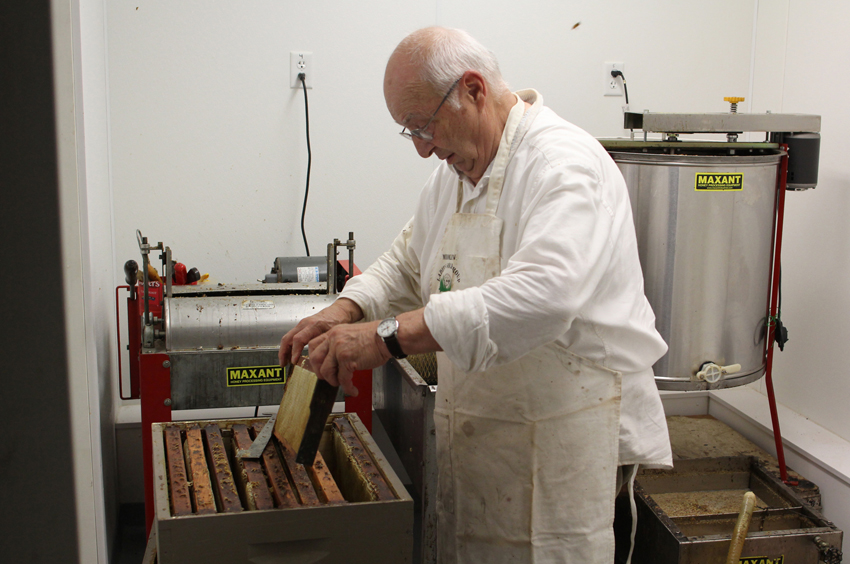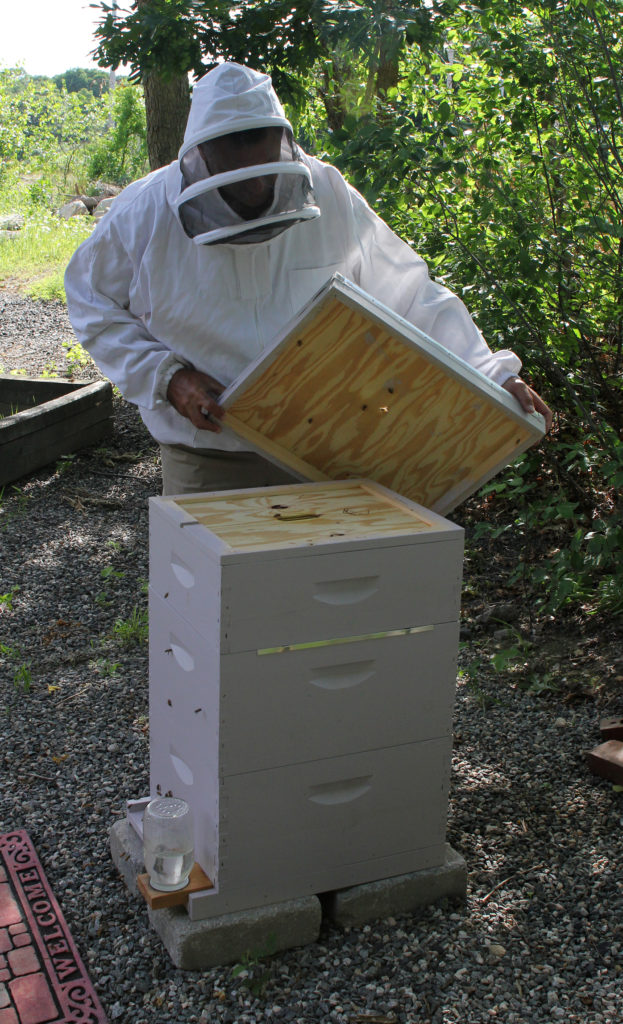
By Leah Dearborn
“Put 14 beekeepers in a room and they’ll tell you 14 different reasons why bees are dying,” says Jay Falcone, who maintains 10 beehives in the Bear Creek Wildlife Sanctuary at Wheelabrator Saugus.
Falcone also maintains hives at Wheelabrator’s Shrewsbury, Mass., landfill, including an observation hive placed inside the conference room there.
Falcone said Wheelabrator and his wife both pushed him to turn his beekeeping hobby into a business about 20 years ago. He owns Buzz N Bee Apiaries in Epping, N.H., and maintains 30 hives for his own business, in addition to the 20 Wheelabrator hives.

Beekeeper Jay Falcone teaches students about bees at the Bear Creek Wildlife Sanctuary in Saugus. | Photo: Reba Saldanha
Donald Musial, general manager of Wheelabrator landfills, says Falcone first approached the company about the idea of hosting hives. It has been a great fit for both the bees and the company, Musial says.
Some dramatic figures about the declining honeybee population have been making a buzz in headlines around the world, but tracking the exact cause of the phenomenon is easier said than done.
Bees first began to disappear en masse in the 1990s, with annual losses over the past decade averaging between 20 and 40 percent of all colonies in the nation each year.
In May, the United States Department of Agriculture (USDA) released the results of its first-ever Honey Bee Colony Loss survey. Over the winter quarter of January through March, U.S. beekeepers lost 17 percent of their colonies.
Those are revealing statistics, and they affect more than just the bee population itself. Bees contribute approximately 11 percent of the country’s agricultural gross domestic product, equal to $14.6 billion each year. If bees were removed from the equation, local grocery stores would find everyday items such as coffee, apples, milk, and butter out of stock.
So what exactly is behind this phenomenon of disappearing bees, dubbed colony collapse disorder (CCD), and is it really as terrifying as the headlines make it sound?
Falcone cites frigid temperatures and unpredictable New England weather as the less-than-mysterious cause of the majority of bee casualties in his own hives.
“Bees check the temperature of the air,” explains Falcone. “If the sun is shining, they go out and navigate around the hive. They always go to the bathroom outside of the hive, because going inside will contaminate the honey.”
Days when the temperature starts out high and suddenly drops are particularly dangerous.
“Once it reaches below 40 degrees, the bees get too cold to fly and can’t make their way back to the hive.”
During a particularly cold winter season, beekeepers might lose 90 to 100 percent of their colonies. Any conversation about CCD, however, is usually accompanied by discussion of at least three factors: verroa mites, pesticides, and bee access to nutrition.
“The main culprits responsible for bee die-offs are the verroa mite,” says Vin Gaglione, a veteran beekeeper with more than three decades of experience and owner of Crystal Bee Supply in Peabody. “They first became a problem in the early ‘80s.”
Varroa mites (varroa destructor) attach themselves to honeybees, compromising their immune systems and spreading viruses. The University of Georgia’s College of Agricultural and Environmental Sciences warns that colonies infested with varroa will die within one to two years if untreated.
Pesticides also play a somewhat more contentious role in bee death.
“The pesticides get on the pollen,” Gaglione explains, “which they then take into their hives, weakening their immune systems and shortening their lives. These neonicotinoid insecticides used to only be used on farms, but now they’re regularly used by lawn care companies. When the brood stores pollen for the winter, beekeepers find them dead in the spring.”

Vin Gaglione works with honey supers at his Peabody shop. | Photo: Owen O’Rourke
Neonicotinoids are meant to circulate through the plant so that crop pests die after taking a single bite. While these chemicals don’t target bees, a high enough dose of the compound can move through the plant and into the pollen. On most farms, it’s only the seed that’s coated with insecticide instead of the whole plant, but there’s speculation that these smaller amounts still travel through the pollen and nectar.
Laboratory experiment results published in the March 2016 issue of the Journal of Insect Physiology found three regularly used neonicotinoids (thiacloprid, imidacloprid, and clothianidin) to have an impact of bees, supporting the theory that pesticides do impair their immune systems.
There’s also the issue of nutrition. Shortly after World War II, farmers began using synthetic fertilizers instead of cover crops like clover and alfalfa, which have traditionally provided additional nutrition for bees.
Gaglione adds that last of all, a lack of care and error on the part of new beekeepers is to blame for a small, but underreported portion of bee deaths.
From his backyard in Lynn, City Councilor Wayne Lozzi began to experiment with beekeeping after a number of co-workers at the Department of Environmental Protection became involved with it as a hobby. He took a beekeeping class with Crystal Bee Supply and attributes everything he knows to them.
Although his hive is only a few months old, Lozzi has yet to witness any unusual bee deaths.
“There are clear indications that the hive is healthy. The queen is active,” explains Lozzi. “Egg-laying is going on. You can see larvae. That’s what you hope as a beekeeper, you hope the population explodes.”
And that’s exactly what his hive has done since he began beekeeping in April.
Lozzi opens up the individual trays to determine whether a new box is needed.

City Councilor Wayne Lozzi tends to the hive in his Lynn backyard. | Photo: Owen O’Rourke
“If it gets overcrowded, they’ll swarm and approximately half will leave, taking the queen with them,” says Lozzi. “The hive falls apart without a queen.”
Of course, Lozzi’s bees only represent a single hive, and a new one at that. But other studies have questioned whether the mass bee die-off is quite as dramatic as it immediately seems. There’s a great deal of conflicting information about the causes of CCD. While some sources point to the damage of pesticides, others question whether its role is overblown.
While Falcone recognizes the impact of pesticides on bees, he doesn’t believe that New England populations have been as heavily affected as insects in larger agricultural centers of the country. He also takes a different approach to treatment of the verroa mite, allowing the process of survival of the fittest to take its course.
“An old farmer once told me, ‘Let the bees be bees.’ Let them figure it out,” says Falcone, who has been beekeeping since the early 1970s. “My colonies have died out with verroa, but verroa dies out, too, in the cold winter. When other hives become overcrowded and swarm, they’ll take over the deserted hive. The bees live on.”
Is there anything that North Shore inhabitants can do to help the local bee population? Falcone recommends planting flowers and spreading seeds as a simple way to provide for bees.
Gaglione’s son and fellow beekeeper, Joe Gaglione, warns that avoiding pesticide use is also a good start, but “if your neighbor’’s still putting it on his lawn, it may not make much of a difference.”
His father seems fairly hopeful about the situation, however. “We know a lot more about how to treat bees for illnesses now,” says Vin Gaglione. “There are also a lot of new people getting into beekeeping, and that helps bring up the population numbers.”






